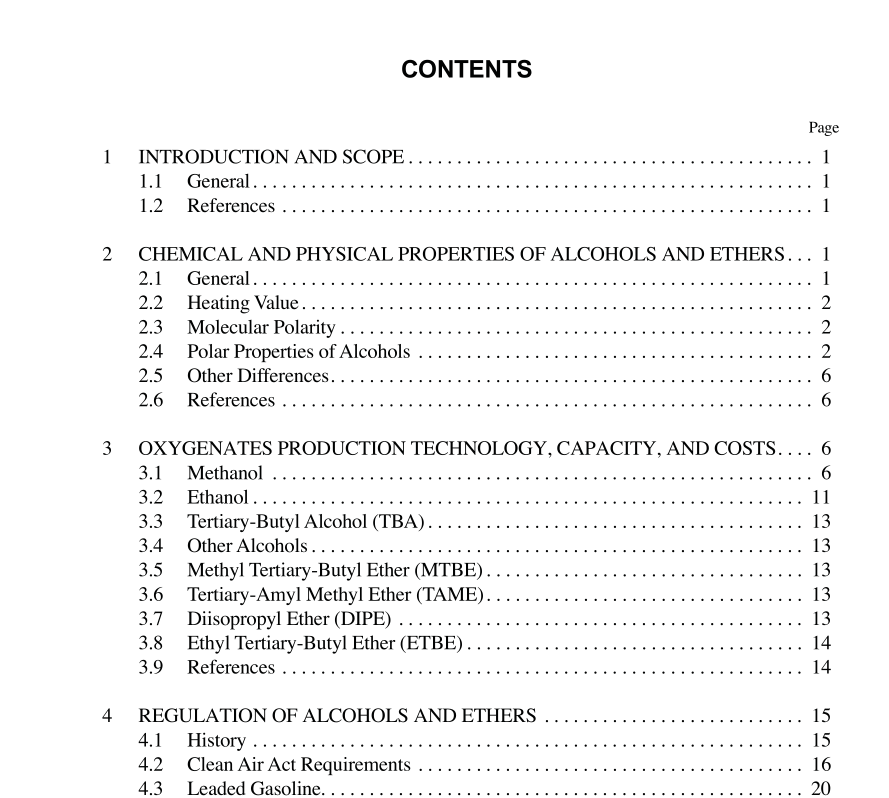API Publ 4261 pdf download

API Publ 4261 pdf download.Alcohols and Ethers—A Technical Assessment of Their Application as Fuels and Fuel Components
1.1 GENERAL
1.1.1 In 1971 the American Petroleum Institute (API) stud- ied the feasibility of blending ethanol with gasoline to aug- ment domestic fuel supplies for transportation. I After the first Arab oil embargo in 1974, interest in using alcohols as fuels expanded to include methanol, not only as a transportation fuel, but also as a fuel for stationary power sources. In response to that expanded interest, the API published an updated technical assessment in 1976.2 1.1.2 Since 1976, many changes have occurred in the use of petroleum and non-petroleum fuels, both neat and in blends with hydrocarbon components. The earlier objective of augmenting domestic energy sources was joined by two additional objectives: a) to produce high octane gasoline without the use of lead alkyls, and b) to reduce the contribu- tion of motor vehicles and stationary sources to air pollution. In response to the expanded use of oxygenates, API published a second updated technical assessment in 1988.3 Today, fed- eral law requires that oxygenates be blended with gasoline in the wintertime in certain areas and be a part of reformulated gasoline in specified areas of the United States. 1.1.3 The Clean Air Act Amendments of 1977 expanded the interest in alcohols and ethers. The Clean Air Act Amend- ments of 1990 mandated the use of oxygenates to reduce win- tertime carbon monoxide emissions in carbon monoxide nonattainment areas. It also required oxygenates in reformu- lated gasoline (RFG) which is mandated for use in extreme and severe ozone nonattainment areas and other ozone nonat- tainment areas which opt to require reformulated gasoline. Nonattainment areas are those areas not meeting the statutory federal standards for ambient carbon monoxide (carbon mon- oxide nonattainment areas) and ozone (ozone nonattainment areas). 1.1.4 New policy issues regarding oxygenates are expected in the future. An important objective of this publication is to provide an updated and expanded technical assessment suit- able as a foundation for policy discussion. 1.1.5 The transportation fuels industry has been shaped by six important events since the issuing of the Clean Air Act Amendments of 1977: a) the increased use of alcohols as blending components, b) the appearance of marketplace con- cerns resulting from the misuse of alcohols as blending com- ponents, c) the implementation of federal environmental regulations covering the composition of motor fuels, d) the onset of federal regulations requiring the use of oxygenates, e) the use of several different ethers as fuel components, and f) the ban on MTBE in California by 2002. In the future, the registration of fuels and fuel additives and the required toxi- cology testing may affect motor fuel composition and the use of oxygenates. 1.1.6 This technical assessment,therefore, has been expanded to include a review of the oxygenate regulations and the technical literature that has been published between 1988 and 1999. This publication summarizes information on producing and applying alcohols and ethers as fuels and fuel components. The alcohols and ethers that are consid- ered include a) methanol, ethanol, isopropyl alcohol (IPA), tertiary-butyl alcohol (TBA), methyl tertiary-butyl ether (MTBE), tertiary-amyl methyl ether (TAME), ethyl tertiary- butyl ether (ETBE), and disopropyl ether (DIPE) as fuel components; b) methanol and ethanol (both neat and mixed with low levels of hydrocarbons) as transportation fuels; and c) methanol in stationary power sources. This publication assesses the technical advantages and disadvantages of alco- hols and ethers with respect to hydrocarbon fuels. The anal- ysis also addresses the following factors: a) the costs associated with producing alcohols and ethers, b) distribu- tion, storage, and fire protection and safety concerns, and c) health and environmental concerns.









